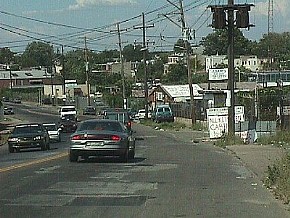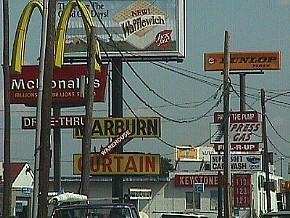01052201 mesh surfaces models perspectives 231ai10
2002.05.22 13:56
Re: the first Agonalia
Doing a web search, one finds out there were/are three Agonalias, and originally the second Agonalia was not dedicated to Janus, but some other archaic Roman god. I suspect that by the third century, the first two Agonalias were centered on Janus.
The Agonalias were indeed sacrificial festivals, and exactly the type of festival that the growing Christian oriented Roman empire was at pains to eradicate.
Like many of the old Christian churches of northeastern Europe that are build upon ancient Druid/Pagan sites, it appears that many Christian holiday/holydays superimpose ancient Pagan festivals. What I find interesting though, is that at least the sites and the days remain special. Kind of makes you wonder if the specialness is there regardless of what 'cloak' presently dresses it.
2002.05.22 14:01
Re: Splintered Urbanism
What seems to missing though is any addressing of the wide spread decay that large cities manifest in parts throughout their 'life'. It seems that parts of many US cities are treated as trash and thus disposable, but where exactly does one throw out parts of cities?
| |
2006.05.22 06:55
genius loci?
 love among the ruins
love among the ruins
 ancient Lenni Lenape trail leading to the summer solstice celebration site
ancient Lenni Lenape trail leading to the summer solstice celebration site
 $1.13 a gallon for regular?!?
$1.13 a gallon for regular?!?
| |
13052201
Quondam District NNTC plan development
2170i38
2013.05.22 11:28
What are the cultural ingredients of architecture today?
$ is a perrenial ingredient of architecture. Is China building so much because now they have lots of money? Yes. Does Dubai exist because of lots of money? Yes.
Just did a google search koolhaas yes culture.
"Junkspace pretends to unite, but it actually splinters. It creates communities not of shared interest or free association, but of identical statistics and unavoidable demographics, an opportunistic weave of vested interests. … Its financing is a deliberate haze, clouding opaque deals, dubious tax breaks, unusual incentives, exemptions, tenuous legalities, transferred air rights, joined properties, special zoning districts, public-private complicities. Funded by bonds, lottery, subsidy, charity, grant: an erratic flow of yen, euros, and dollars (¥?$)."
and
Let me ask you about your quote about the need to "accept the world in all it's sloppiness and somehow make that into a culture." Does this still reflect your current thinking?
Rem Koolhaas: Well, yes and no. Of course, behind every project we do there is a kind of vast critical apparatus of doing better. We're not trying to emulate the current mess. We are just as interested in the sublime. Actually, that is why I'm talking about the other buildings we are doing, because they are really exceptionally ambitious in terms of not emulating confusion or something, but ambitious as architectural works in and of themselves.
on architecture and capitalism . . .
Rem Koolhaas: I think what Mies tried to do is find a way to make the sublime compatible with capitalism . . . extract from capitalism the kind of elements that are sublime. . . . I think that the first real engagement with the aesthetics of capitalism is a kind of transcending it.
I think that after that, perhaps (Robert) Venturi and (Denise) Scott Brown were the second wave of looking at capitalism, perhaps with a greater sense of realism. The presence of capitalism and the results of capitalism were much more blatantly present, making it clear that you could almost not transcend it anymore, and you needed to find some accommodation with its aesthetics.
And I think that if you place Mies in the late 40's or early 50's, and if you place the beginning of the Venturi's thing in the late 60's or early 70's, then 20 years later of course globalization and the market euphoria become even more unfettered, and that is why I had to begin to look, with the Harvard project, at shopping, because I think that at that point almost all architectural production had contracted and focused on this one program, which in itself had morphed in such a way that it now included everything, all components. So for me, it was very important to address that, and also to see whether those demands had actually fundamentally changed the kind of spaces that we produce and the spaces that we need.
So you could say that the Venturi's are in the middle in terms of having a kind of positive relationship with the iconography of capitalism. Mies in a way stood above it, and Junkspace was a more internal look, when the positive attitude of the Venturi's was no longer tenable and where we had to admit and realize it was actually a much more ominous development. So, in a way, Junkspace is a theory, and what for me is very important about this building (the IIT Student Center) is that it tried to really work not so much within the same vocabulary but see what an architect could still do within that syndrome or within that regime.
You're so good at defining the reality of the world - the good things and the horrible things - that sometimes when I read your writings, it's very hard for me to see what you actually think about the things you're describing.
Rem Koolhaas: There are so many opinions in architecture. I think in the beginning it was just kind of exciting to describe and not to give so many opinions. If you read them (Koolhaas's writings), you also feel that you are in the presence of a very critical mind, or at least I hope so. Certainly in the case of Junkspace I think that should be overwhelming. But at the same time, I don't want to simplify things and say I'm against them when they have a degree of inevitability, but I would say our buildings are more and more able to really disconnect from those realities, or try to make the best out of them.
Is Bjarke "Yes is More" Ingels architecture's leading hipster?
Is "Design like you don't give a damn" implicit?
In perspective then: a monster[ous] grand tour[ism of] the real taboo domain.
Is Network Culture ever going to be a book?
"Look Bullwinkle, a message in a bottle!"
"Fan-mail from some flounder?"
Scripting. 3D printing. Ride the wave into the future?
"Architects inherently want to make the world a better place."
I attended a Denise Scott Brown lecture back in the (early-mid) 90s. She used the word 'boring" several times, as in, "Here's another boring plan." During the Q&A I wanted to ask, "So, are you trying to tell us that a bore is more?"
| |
17052201 Gehry Residence plans elevations 223ei01
17052202 Graves Residence plans elevations 225fi01
17052201 MVRDV Seoullo 7017 Skygarden Seoul
18052201 Villa Shodhan plans 217si02
18052202 Maison Dom-ino Salon d'Automne Maison du Peintre Ozenfant Maison La Roche-Jeanneret Villa Stein de Monzie Villa à Garches Single House Weissenhof Villa Baizeau Composition Three Maison de M.X Villa Savoye Pavillon Suisse Maison Curutchet Governor's Palace Unité d'Habitation Monastery of La Tourette Maisons Jaoul Villa Shodhan Maison de l'Homme plans 2140i20
18052203 Philadelphia plans iq14 15 16 18 19 2093i76
19052201 plans @ Franklin's kite flying site 2200x1100 iq19-20-23-24 2253i10
19052202 Pantheon Altes Museum Trenton Jewish Community Center Bathhouse Kimbell Art Museum Hurva Synagogue plans osmotic architecture 206gi47
21052201 San Stefano plans work image 207ei03
21052202 Pazzi Chapel plan elevation section work data 2088i01
21052203 Santo Spirito plan (elevation section working data) 2089i01
21052204 Santa Maria della Grazie plan elevation section working data 207di02
21052205 religious Stonehenge Temple of Poseidon Parthenon Great Stupa Temple of Horus Pantheon Temple of Venus and Rome Basilica of Sts. Peter and Marcellinus Basilica of St. Agnes Sts. Sergius and Bacchus Hagia Sophia Mahabodhi Temple Dome of the Rock Great Mosque of Damascus Shore Temple Mosque-Cathedral of Córdoba Lingaraja Temple Basilica of the Madeleine Thoronet Abbey Our Lady of Reims San Stefano Kölner Dom Pazzi Chapel Tempio Malatestiano Santo Spirito Santa Maria della Grazie Tempietto plans iq27 2061i20
|